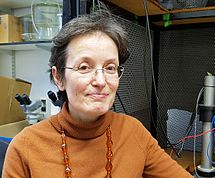Lucia Sivilotti
Professor Lucia G. Sivilotti | |
|---|---|
 | |
| Born | 1957 (age 67–68) |
| Citizenship | Italian |
| Alma mater | |
| Known for |
|
| Scientific career | |
| Fields |
|
| Institutions | |
| Thesis | Pharmacological actions of neutral amino acids on synaptic transmission in the frog optic tectum (1988) |
| Doctoral advisor | Andrea Nistri |
| Website | https://www.ucl.ac.uk/biosciences/departments/npp/people/ls [dead link] http://www.onemol.org.uk |
Lucia Giulia Sivilotti holds the A.J. Clark Chair of Pharmacology at University College London.[1] Her work is aimed at understanding the functioning of receptors that mediate fast synaptic transmission, and focuses on two classes of ion channels in the nicotinic superfamily, nicotinic and glycine receptors.
Early life and education
[edit]Professor Sivilotti graduated in Pharmaceutical Chemistry from the University of Ferrara in Italy . After graduate work in Ferrara and Milan on the modulation of transmitter release in the CNS, she was awarded travelling fellowships by the Royal Society and the Italian Ministry of Education to work at St Bartholomew's Hospital Medical College in London. This project led to the description of what is now called the GABAC receptor[2] and the award of a PhD in 1988. After a career break for family reasons, she undertook postdoctoral work at UCL, first with Clifford J. Woolf in the Anatomy Department, then with David Colquhoun in Pharmacology. In 1997 she joined The School of Pharmacy as a lecturer in Pharmacology, before moving back to UCL in 2003. She became a Professor of Pharmacology in 2008. [1]
Scientific work
[edit]Sivilotti uses electrophysiological methods to assess receptor function, combined with molecular biology methods to alter receptor structure. In addition she collaborates with crystallographers and molecular dynamicists to complement the functional work. [1]
Her lab specialises in recording single ion channel activity and analysing it by the fitting of activation mechanisms. Mechanisms specify the number of conformations in which the channel-receptor protein can exist, the number of ligand molecules bound, and the connections between the states. Fitting them to the data allows the estimation of rate and equilibrium constants for transition between states.
In 2004, Sivilotti et al. produced evidence that the glycine receptor had a short-lived shut conformation (dubbed the "flipped" conformation) that had a higher affinity for glycine than the resting conformation, and was a necessary precursor to the opening of the channel,.[3][4] In 2008, her group showed that partial agonists were partial because of their limited ability to generate this flipped conformation,.[5][6] The channel opening and shutting rates were similar for all agonists, contrary to what had been thought for 50 years[7]
A list of Sivilotti's scientific publications can be found on the UCL site,[8] in Google Scholar,[9] and on her web site, OneMol.org.uk[10]
Recognition
[edit]Editorial positions
[edit]2014. Austrian Science Fund Panel, Vienna, Austria.
2010. Austrian Science Fund Panel, Vienna, Austria.
2000-2004. Editorial Board of the British Journal of Pharmacology.
2015 onwards. Advisory Editorial Board of the Journal of General Physiology (USA)
2018 onwards Board of Reviewing Editors of Science
Named lecture
[edit]2014 Gary Price Memorial Lecture, British Pharmacological Society meeting, London[11]
2018 Fabio Ruzzier Memorial Lecture, Societa' Italiana di Fisiologia, Florence
Other recognition (current)
[edit]Trustee and council member of the Physiological Society (2012-2016)
References
[edit]- ^ Sivilotti, Lucia. "Prof Sivilotti's lab page". UCL. Retrieved 6 January 2017.
- ^ Nistri, A; Sivilotti, L (1985). "An unusual effect of y-aminobutyric acid on synaptic transmission of frog tectal neurones in vitro". British Journal of Pharmacology. 85 (4): 917–921. doi:10.1111/j.1476-5381.1985.tb11092.x. PMC 1916654. PMID 2994789.
- ^ Burzomato; et al. (1 December 2004). "Single-Channel Behavior of Heteromeric α1β Glycine Receptors: An Attempt to Detect a Conformational Change before the Channel Opens". Journal of Neuroscience. 24 (48): 10924–10940. doi:10.1523/jneurosci.3424-04.2004. PMC 6730200. PMID 15574743. Retrieved 9 January 2017.
- ^ Burzomato; et al. (2011-03-10). "Single-Channel Behavior of Heteromeric α1β Glycine Receptors: An Attempt to Detect a Conformational Change before the Channel Opens". OneMol.org.uk. L. Sivilotti. Retrieved 9 January 2017.
- ^ Lape; et al. (7 August 2008). "On the nature of partial agonism in the nicotinic receptor superfamily". Nature. 454 (7205): 722–727. doi:10.1038/nature07139. PMC 2629928. PMID 18633353.
- ^ Lape; et al. (2011-03-10). "On the nature of partial agonism in the nicotinic receptor superfamily". OneMol.org.uk. L.Sivilotti. Retrieved 9 January 2017.
- ^ Sivilotti, L.G. (2010). "What single-channel analysis tells us of the activation mechanism of ligand-gated channels: the case of the glycine receptor". Journal of Physiology. 588 (1): 45–58. doi:10.1113/jphysiol.2009.178525. PMC 2821546. PMID 19770192.
- ^ Sivilotti, Lucia. "Publications on UCL (IRIS)". UCL. Retrieved 9 January 2017.
- ^ Sivilotti, Lucia. "Publications in Google Scholar". Retrieved 9 January 2017.
- ^ Sivilotti, Lucia (2011-03-10). "Publications from UCL single ion channel group". OneMol.org.uk. L.Sivilotti. Retrieved 9 January 2017.
- ^ Sivilotti, Lucia. "Gary Price lecture, 2014. Agonist efficacy- the view from the single receptor". Youtube. British Pharmacological Society. Retrieved 9 January 2017.
